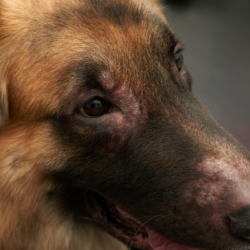Canine leishmaniasis is caused by Leishmania infantum and is transmitted by the bite of sand flies (small 2-3mm midges that bite at dusk and at night). Leishmaniasis is caused by protozoa (unicellular parasites) of the genus Leishmania. Infected dogs are the main domestic reservoir of the parasite and play a key role in transmission to humans, in whom the parasite produces visceral leishmaniasis..
What is canine leishmaniasis ?
Leishmaniasis is a major zoonotic infectious disease caused by the development and multiplication, mainly in cells of the mononuclear phagocyte system, of a flagellated protozoan of the genus Leishmania. This parasitosis transmitted by Psychodidae of the genus Phlebotomus therefore affects humans and animals, and more particularly our domestic dogs, considered to be the main reservoir for humans.
On the other hand, canine leishmaniasis is a disease with a very wide spectrum of clinical manifestations which is fatal in untreated dogs. Although transmission to humans remains rare, canine leishmaniasis is a major zoonosis (disease transmissible to humans from animals), and the dog’s reservoir role continues to pose public health risk management issues. These findings, associated with therapeutic and preventive issues, justify the continuing and growing interest in this protozoan disease.
A little history
Infection with Leishmania infantum was first described in 1908 by Nicolle and Comte in Tunisia. Since then, knowledge about it has been constantly evolving both in terms of physio-pathogenic and immunological mechanisms as well as therapeutic or preventive means. Recent research has also highlighted new concepts in epidemiology. These represent a source of information that is necessary and must be taken into account for the implementation of treatment and control programs.
Epidemiological concepts
There are two major epidemiological concepts in canine leishmaniasis :
- Some dogs will develop severe clinical signs of disease following infection due to their inability to develop an effective cell-mediated response coupled with a strong but ineffective humoral-mediated response
- The other category is made up of dogs that remain infected for a long period, years or even their entire life, without reporting clinical signs or lesions following their infection. However, it is important to remember that any change in their health status (such as the administration of an immunosuppressive treatment for another condition or another immunosuppressive disease) can lead to the activation of this latent infection and the development of clinical signs.
What are the symptoms of leishmaniasis ?
- Hair loss, around the eyes and muzzle
- Weight loss despite a normal appetite
- Bedsores, ulcers, skin inflammation, scales …
- When the disease is at a very advanced stage, the dog’s claws start to grow at an abnormal speed.
- Lameness but also kidney failure can occur
These symptoms only appear several months, and in some cases several years, after contamination, which makes the diagnosis more complicated.
If in doubt, do not wait to go to your veterinarian who can perform a blood test to detect the disease.
How to prevent canine leishmaniasis ?
Prevention is based on the rigorous application of protective measures against insect bites :
- Regularly apply an insecticide repellent effective against sandflies
- Eliminate sandflies from your home
- Bring your dog home before dusk, when sandflies are particularly active
- Prevent the dog from sleeping outside during risky seasons, which are the hottest
- Avoid walks at dusk or dawn
- Do not accumulate organic matter, as it feeds the mosquito larvae
- Put screens on doors and windows
- Vaccinate your dog against leishmaniasis
Dogs are an important reservoir for the parasite. If you live in the south-east of France, ask your veterinarian to teach you how to recognize possible symptoms of leishmaniasis in your dog.
Is there a natural treatment for leishmaniasis ?
The Lapacho :
Lapacho has an anti-amastigote effect. Treatment involves disease control or the use of intervention measures, although the drugs currently in use require long-term treatment and exhibit reduced toxicity and efficacy.
The use of natural products isolated from plants, such as lapacho; an abundant naphthoquinone naturally present in the South American species of Handroanthus, indeed seems a promising option for the treatment of leishmaniasis.
Sources :
- Leishmaniose, OMS 2018
- Guide de la santé en voyage, Vidal 2007
- Teixeira MJ, de Almeida YM, Viana JR, Holanda Filha JG, Rodrigues TP,. Prata JR Jr, Coêlho IC, Rao VS, Pompeu MM. In vitro and in vivo Leishmanicidal activity of 2-hydroxy-3-(3-methyl-2-butenyl)-1,4-naphthoquinone (lapachol). Phytother Res 2001
- ALVAR J, CANAVATE C, MOLINA R, MORENO J, NIETO J. (2004). Canine leishmaniasis. Adv. Parasitol
- AMORA S. S A, BEVILAQUA C. M L, FEIJO F. M C, ALVES N D, MACIEL M. V. (2009) Control of Phlebotomine (Diptera : Psychodidae) Leishmaniasis Vectors. Neotropical Entomology
- CARILLO E, MORENO J (2009) Cytokine profiles in canine visceral leishmaniasis. Veterinary Immunology and Immunopathology





